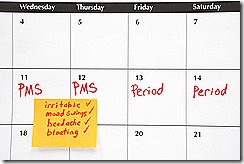 Premenstrual syndrome (PMS) includes one or more of many symptoms in the areas of mood, the physical body and cognition. The most frequent symptoms are irritability, depression, fatigue, water retention, weight gain, breast tenderness, headaches, abdominal cramps and mood swings. About 80% of women may experience PMS and about 50% of women seek medical care for their symptoms.
Premenstrual syndrome (PMS) includes one or more of many symptoms in the areas of mood, the physical body and cognition. The most frequent symptoms are irritability, depression, fatigue, water retention, weight gain, breast tenderness, headaches, abdominal cramps and mood swings. About 80% of women may experience PMS and about 50% of women seek medical care for their symptoms.
The primary etiology of PMS has been thought to be the interplay of serotonin and hormones which is why conventional treatment of PMS most often includes SSRIs to increase serotonin levels and/or birth control pills to suppress ovarian hormone secretion.
High sensitivity C-reactive protein (hs-CRP) is an acute phase inflammatory marker that has been associated with risk for cardiovascular disease and menopausal hot flash symptoms. It has also been associated with some of the risk factors for PMS including depression, smoking, increased body mass index (BMI) and aging. Some studies have investigated the role of inflammation and PMS but only suggestive not significant connections have been observed. Select anti-inflammatory medications can also provide relief for some PMS symptoms.
The current study used data on PMS symptoms from a much larger study called the Study of Women’s Health Across the Nation (SWAN), a racially and ethnically diverse study of midlife women from five racial/ethnic groups and at seven clinical sites nationwide. The goal was to determine if hs-CRP was associated with PMS. The proportion of women who reported each PMS symptom, except breast pain or headaches, was significantly increased (26%-41%) for women who had hs-CRP values > 3 mg/L. A hs-CRP level > 3 mg/L in women with PMS was associated with mood symptoms, abdominal cramps, back pain, appetite cravings, weight gain, and bloating, but not with headaches, breast pain for women with three or more PMS symptoms.
Most symptoms, except for headaches and breast pain were reported by significantly more obese women, women who smoked or were exposed to passive smoke and by women with an elevation of depressive symptom scores.
Commentary: There has been very little literature that has focused on any relationship between inflammation and PMS. The current study that does observe a significant relationship with at least some PMS symptoms and in women who have less than 3 PMS symptoms suggests that inflammation may be involved in PMS. That said, I would not abandon the serotonin-hormone connection and would continue to recognize that PMS is likely a complex disorder with potentially different mechanisms for the etiologies of at least some of the symptoms. In addition to biology, there are numerous social, demographic and behavioral factors that are likely associated with PMS. The lifestyle and natural agents that have published research support that I rely on the most in clinical practice are aerobic exercise 4 or more times per week, St John’s wort, calcium, vitamin B6, chaste tree, magnesium, vitamin E and borage seed or evening primrose oil. For more difficult mood disorder PMS patients, usually called premenstrual dysphoric disorder (PMDD), I add one or more of the following: tryptophan, theanine, lavender, GABA, SAMe and more.
Reference
Ellen B. Gold, PhD, Craig Wells, BA, and Marianne O’Neill Rasor, MA. The Association of inflammation with premenstrual syndrome. J Women’s Health 2016; May on line ahead of print

